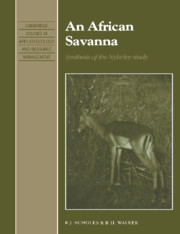Book contents
- Frontmatter
- Contents
- Preface
- I Nylsvley in an African savanna context
- 1 African savannas: an overview
- 2 The people of Nylsvley
- 3 The climate at Nylsvley
- 4 Geology, landform and soils
- 5 The Nylsvley biota
- II The key determinants: water, nutrients, fire and herbivory
- III The carbon cycle
- IV Community and landscape pattern and change
- Part V Lessons from Nylsvley
- Bibliography
- Index
1 - African savannas: an overview
Published online by Cambridge University Press: 06 October 2009
- Frontmatter
- Contents
- Preface
- I Nylsvley in an African savanna context
- 1 African savannas: an overview
- 2 The people of Nylsvley
- 3 The climate at Nylsvley
- 4 Geology, landform and soils
- 5 The Nylsvley biota
- II The key determinants: water, nutrients, fire and herbivory
- III The carbon cycle
- IV Community and landscape pattern and change
- Part V Lessons from Nylsvley
- Bibliography
- Index
Summary
Africa presents two dominant images to the world. One is of natural disaster, human suffering and environmental degradation. The other, paradoxically, is of boundless vistas, teeming with wildlife. The backdrop to both these images is a vegetation characteristically African, and offering a paradox of its own. Although it may have abundant grass, it does not seem to be a grassland, because it also has many trees; yet the trees are not sufficiently dense and tall to be called a forest. All efforts to bound it by precisely defining its limits end in pointless argument, since it grades imperceptibly into dry forest on the one hand, and desert shrublands and grasslands on the other. It is highly changeable, both over short distances and over the brief time for which it has been scientifically studied, and yet it is always there in some form; old as the landscape, older by far than us. These are the savannas of Africa, the cradle in which our species evolved.
This book is a synthesis of ecological knowledge concerning one African savanna site, Nylsvley, which has been studied in detail. However, the insights gained in that study have relevance to savannas in other areas of Africa and the world. The purpose of this chapter is to place the Nylsvley savannas within a global, continental and local context.
- Type
- Chapter
- Information
- An African SavannaSynthesis of the Nylsvley Study, pp. 2 - 16Publisher: Cambridge University PressPrint publication year: 1993
- 3
- Cited by



